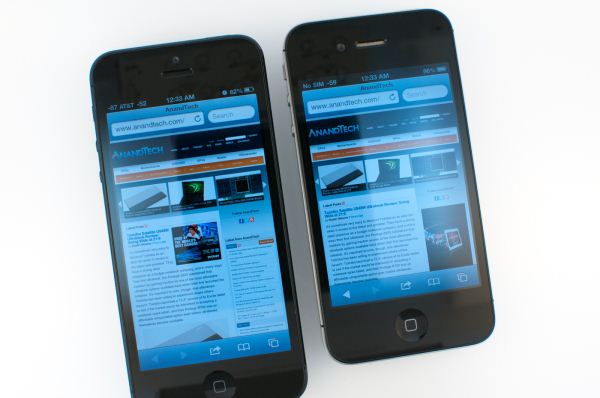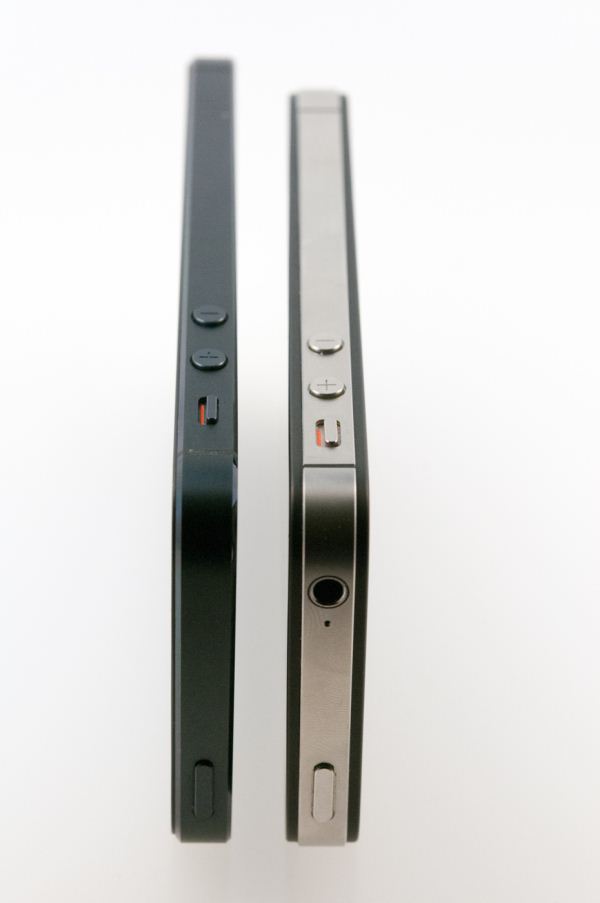The iPhone 5 Review
by Anand Lal Shimpi, Brian Klug & Vivek Gowri on October 16, 2012 11:33 AM EST- Posted in
- Smartphones
- Apple
- Mobile
- iPhone 5
The last significant redesign of the iPhone platform came in 2010 with the iPhone 4. It was an update that literally touched all aspects of the device, from SoC to display to baseband and of course, chassis. Last month’s launch of the iPhone 5 is no different in magnitude. The sixth generation iPhone makes some of the biggest changes to the platform since its introduction in 2007.
Visually the device begins by evolving the design language of the iPhone 4/4S chassis. From the launch of the iPhone 4 it was quite obvious that Apple had picked a design it was quite proud of. Thus it’s not too surprising that, from a distance, the iPhone 5 resembles the previous two iPhone models. We’ll get into material differences shortly, but what make the iPhone 5 design such a radical departure is its larger display.
All previous iPhones have maintained the same 3.5-inch, 3:2 aspect ratio display. With the rest of the world quickly moving to much larger displays, and with 16:9 the clear aspect ratio of choice, when faced with the decision of modernizing the iPhone platform the choice was obvious.
The iPhone 5 embraces a taller, 4-inch, 16:9 1136 x 640 display opting to lengthen the device instead of increasing its area in both dimensions. The result is a device that is distinctly an iPhone, albeit a modern one. The taller display doesn’t do much to make desktop web pages any easier to read as a result of the width staying the same. Those longing for an HTC One X or Galaxy S 3 sized device running iOS are out of luck. Reading emails and typing are both improved though as there’s now more room for lists and the keyboard no longer occupies as much of the display. The taller device can be more awkward to use if you have smaller hands, but the added screen real estate is honestly worth it. Once you get used to the iPhone 5’s display, going back to the older models is tough.
The taller chassis went on a diet as well. The iPhone 5 is now considerably thinner and lighter than its predecessor, which is yet another factor that contributes to it feeling more modern.
Internally the device changes are just as significant, if not more, than those on the outside. The iPhone 5 includes LTE support, which in areas where LTE networks are deployed can be enough reason alone to warrant an upgrade.
The iPhone 5 also includes a brand new SoC from Apple: the A6. For the first time since the introduction of the iPad, Apple has introduced a major branded SoC on an iPhone first. The iPhone 4 used the A4 after it debuted on the iPad, and the 4S picked up the A5 months after the iPad 2 launched with it. The A6 however arrives first on the iPhone 5, and with it comes two of Apple’s first, custom designed CPU cores. We’ve always known Apple as a vertically integrated device and software vendor, but getting into CPU design takes that to a new level.
| Physical Comparison | ||||
| Apple iPhone 4S | Samsung Galaxy S 3 (USA) | HTC One S | Apple iPhone 5 | |
| Height | 115.2 mm (4.5") | 136.6 mm (5.38" ) | 130.9 mm (5.15" ) | 123.8 mm (4.87") |
| Width | 58.6 mm (2.31") | 70.6 mm (2.78") | 65 mm (2.56") | 58.6 mm (2.31") |
| Depth | 9.3 mm ( 0.37") | 8.6 mm (0.34") | 7.8 mm (0.31") | 7.6 mm (0.30") |
| Weight | 140 g (4.9 oz) | 133g (4.7 oz) | 119.5g (4.21 oz) | 112 g (3.95 oz) |
| CPU | Apple A5 @ ~800MHz Dual Core Cortex A9 | 1.5 GHz MSM8960 Dual Core Krait | 1.5 GHz MSM8260A Dual Core Krait | 1.3 GHz Apple A6 (Dual Core Apple Swift) |
| GPU | PowerVR SGX 543MP2 | Adreno 225 | Adreno 225 | PowerVR SGX 543MP3 |
| RAM | 512MB LPDDR2-800 | 2 GB LPDDR2 | 1 GB LPDDR2 | 1 GB LPDDR2 |
| NAND | 16GB, 32GB or 64GB integrated | 16/32 GB NAND with up to 64 GB microSDXC | 16 GB NAND | 16, 32, or 64 GB integrated |
| Camera | 8 MP with LED Flash + Front Facing Camera | 8 MP with LED Flash + 1.9 MP front facing | 8 MP with LED Flash + VGA front facing | 8 MP with LED Flash + 1.2MP front facing |
| Screen | 3.5" 960 x 640 LED backlit LCD | 4.8" 1280x720 HD SAMOLED | 4.3" 960x540 Super AMOLED | 4" 1136 x 640 LED backlit LCD |
| Battery | Internal 5.3 Whr | Removable 7.98 Whr | Removable 6.1 Whr | Internal 5.45 Whr |
There’s a lot to talk about when it comes to the new iPhone. Whether it is understanding the architecture of the A6 SoC or investigating the improved low light performance of the iPhone 5’s rear facing camera, we’ve got it here in what is easily our most in-depth iPhone review to date. Let’s get started.












276 Comments
View All Comments
medi01 - Wednesday, October 17, 2012 - link
Try to do it in a darker environment.If you still don't notice that AMOLED black is actually, cough, black and "iphone"'s black is actually gray, you probably should visit a doctor.
darwiniandude - Friday, October 19, 2012 - link
Who cares about black being 100% black when all the colour accuracy is terrible? The galaxy note looks like is has cellophane over the screen next to an iPhone, the white doesn't look white. You take a photo of a hill side and all the trees and grass is the same over saturated shade of green. It's because of this that I'd only consider the HTC one X excuse it has an accurate LCD. I've personally never found an Amoled screen so far I can put up with. Each to their own, if black is more important to you than the rest of the spectrum, then enjoy it.bpear96 - Thursday, October 18, 2012 - link
Well obiously, there PPI's are almost the same, because of the size difference.If you had a 4.8" 1136 x 640 display, next to a 4" 1136 x 640 the 4.8" would not look nearly as good as the 4" because it would have a lower PPI (pixels per inch) since the GS3 is larger it needs a higher res display to be on par with the 4" iphone 5 display.
bpear96 - Thursday, October 18, 2012 - link
type - obviously *star-affinity - Tuesday, October 23, 2012 - link
The difference (in my opinion) being that the Galaxy S III has over saturated colors which is quite bad.http://www.displaymate.com/Smartphone_ShootOut_2.h...
GabeA - Saturday, January 5, 2013 - link
Sorry, you're comparing a poor screen technology (PenTile subpel matrix) with a top-of-the-line LCD. The comparison is flawed because the effective resolution on text is only ~82% in either direction (something like 1050 x 590 on sharp, black text) due to the interpolated, non-RGB subpixels.A good comparison would absolutely involve the One X series by HTC. In fact, holding the SGS3 and the One X side by side on this page shows an obvious difference in text clarity in favor of the One X.
rocketbuddha - Tuesday, October 16, 2012 - link
Don't you know that every iPhone comes with the halo of the RDF (Reality Distortion Field) :DThus things that other things have been having for months/years in other models appear antiquated/vanish once iPhone comes near ;-)
doobydoo - Friday, October 19, 2012 - link
So having the fastest hardware in any smartphone ever, the iPhone 5 was late to the party?Or was it the fact that it's the thinnest that you're claiming they copied from Android. Or lightest, or thinnest, or shortest, or battery life.
I wonder when any Android phone (bar the Razr Maxx which lets face it is a brick) will catch up?
A5 - Tuesday, October 16, 2012 - link
So you want a Droid Razr HD Maxx, then?webmastir - Tuesday, October 16, 2012 - link
Yep. That should be the #1 choice at the moment.